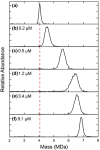MASS SPECTROMETRY IN VIROLOGICAL SCIENCES
- PMID: 31876329
- PMCID: PMC7228374
- DOI: 10.1002/mas.21617
MASS SPECTROMETRY IN VIROLOGICAL SCIENCES
Abstract
Virology, as a branch of the life sciences, discovered mass spectrometry (MS) to be the pivotal tool around two decades ago. The technique unveiled the complex network of interactions between the living world of pro- and eukaryotes and viruses, which delivered "a piece of bad news wrapped in protein" as defined by Peter Medawar, Nobel Prize Laureate, in 1960. However, MS is constantly evolving, and novel approaches allow for a better understanding of interactions in this micro- and nanoworld. Currently, we can investigate the interplay between the virus and the cell by analyzing proteomes, interactomes, virus-cell interactions, and search for the compounds that build viral structures. In addition, by using MS, it is possible to look at the cell from the broader perspective and determine the role of viral infection on the scale of the organism, for example, monitoring the crosstalk between infected tissues and the immune system. In such a way, MS became one of the major tools for the modern virology, allowing us to see the infection in the context of the whole cell or the organism. © 2019 John Wiley & Sons Ltd. Mass Spec Rev.
Keywords: GEMMA-MS; capsids; charge-detection mass spectrometry; viral infections.
© 2019 John Wiley & Sons Ltd.
Figures








Similar articles
-
Structural mass spectrometry goes viral.Adv Virus Res. 2019;105:189-238. doi: 10.1016/bs.aivir.2019.07.003. Epub 2019 Aug 27. Adv Virus Res. 2019. PMID: 31522705
-
Mass spectrometry based proteomic studies on viruses and hosts--a review.Anal Chim Acta. 2011 Sep 30;702(2):149-59. doi: 10.1016/j.aca.2011.06.045. Epub 2011 Jun 30. Anal Chim Acta. 2011. PMID: 21839192 Free PMC article. Review.
-
Methods related to molecular virology.Methods. 2011 Oct;55(2):107-8. doi: 10.1016/j.ymeth.2011.10.012. Methods. 2011. PMID: 22050902 No abstract available.
-
Modern biomolecular mass spectrometry and its role in studying virus structure, dynamics, and assembly.Angew Chem Int Ed Engl. 2011 Aug 29;50(36):8248-62. doi: 10.1002/anie.201008120. Epub 2011 Jul 26. Angew Chem Int Ed Engl. 2011. PMID: 21793131 Free PMC article. Review.
-
Proteomic approaches to uncovering virus-host protein interactions during the progression of viral infection.Expert Rev Proteomics. 2016;13(3):325-40. doi: 10.1586/14789450.2016.1147353. Expert Rev Proteomics. 2016. PMID: 26817613 Free PMC article. Review.
Cited by
-
Mass spectrometry analytical responses to the SARS-CoV2 coronavirus in review.Trends Analyt Chem. 2021 Sep;142:116328. doi: 10.1016/j.trac.2021.116328. Epub 2021 May 11. Trends Analyt Chem. 2021. PMID: 33994605 Free PMC article. Review.
-
Application and Perspectives of MALDI-TOF Mass Spectrometry in Clinical Microbiology Laboratories.Microorganisms. 2021 Jul 20;9(7):1539. doi: 10.3390/microorganisms9071539. Microorganisms. 2021. PMID: 34361974 Free PMC article. Review.
-
Metagenomic next-generation sequencing and proteomics analysis in pediatric viral encephalitis and meningitis.Front Cell Infect Microbiol. 2023 Apr 21;13:1104858. doi: 10.3389/fcimb.2023.1104858. eCollection 2023. Front Cell Infect Microbiol. 2023. PMID: 37153144 Free PMC article.
-
Application of Proteomics Technology Based on LC-MS Combined with Western Blotting and Co-IP in Antiviral Innate Immunity.Methods Mol Biol. 2025;2854:93-106. doi: 10.1007/978-1-0716-4108-8_11. Methods Mol Biol. 2025. PMID: 39192122
-
Mass Spectrometry-Based Characterization of the Virion Proteome, Phosphoproteome, and Associated Kinase Activity of Human Cytomegalovirus.Microorganisms. 2020 May 30;8(6):820. doi: 10.3390/microorganisms8060820. Microorganisms. 2020. PMID: 32486127 Free PMC article. Review.
References
-
- Alexander MM, Mohr JP, DeBlasio SL, Chavez JD, Ziegler‐Graff V, Brault V, Bruce JE, Heck MC. 2017. Insights in luteovirid structural biology guided by chemical cross‐linking and high resolutionmass spectrometry. Virus Res 241:42–52. - PubMed
-
- Allmaier G, Laschober C, Szymanski WW. 2008. Nano ES GEMMA and PDMA, new tools for the analysis of nanobioparticles‐protein complexes, lipoparticles, and viruses. J Am Soc Mass Spectrom 19(8):1062–1068. - PubMed
-
- Bacher G, Szymanski WW, Kaufman SL, Zöllner P, Blaas D, Allmaier G. 2001. Charge‐reduced nano electrospray ionization combined with differential mobility analysis of peptides, proteins, glycoproteins, noncovalent protein complexes and viruses. J Mass Spectrom 36(9):1038–1052. - PubMed
Publication types
MeSH terms
Substances
LinkOut - more resources
Full Text Sources
Research Materials

